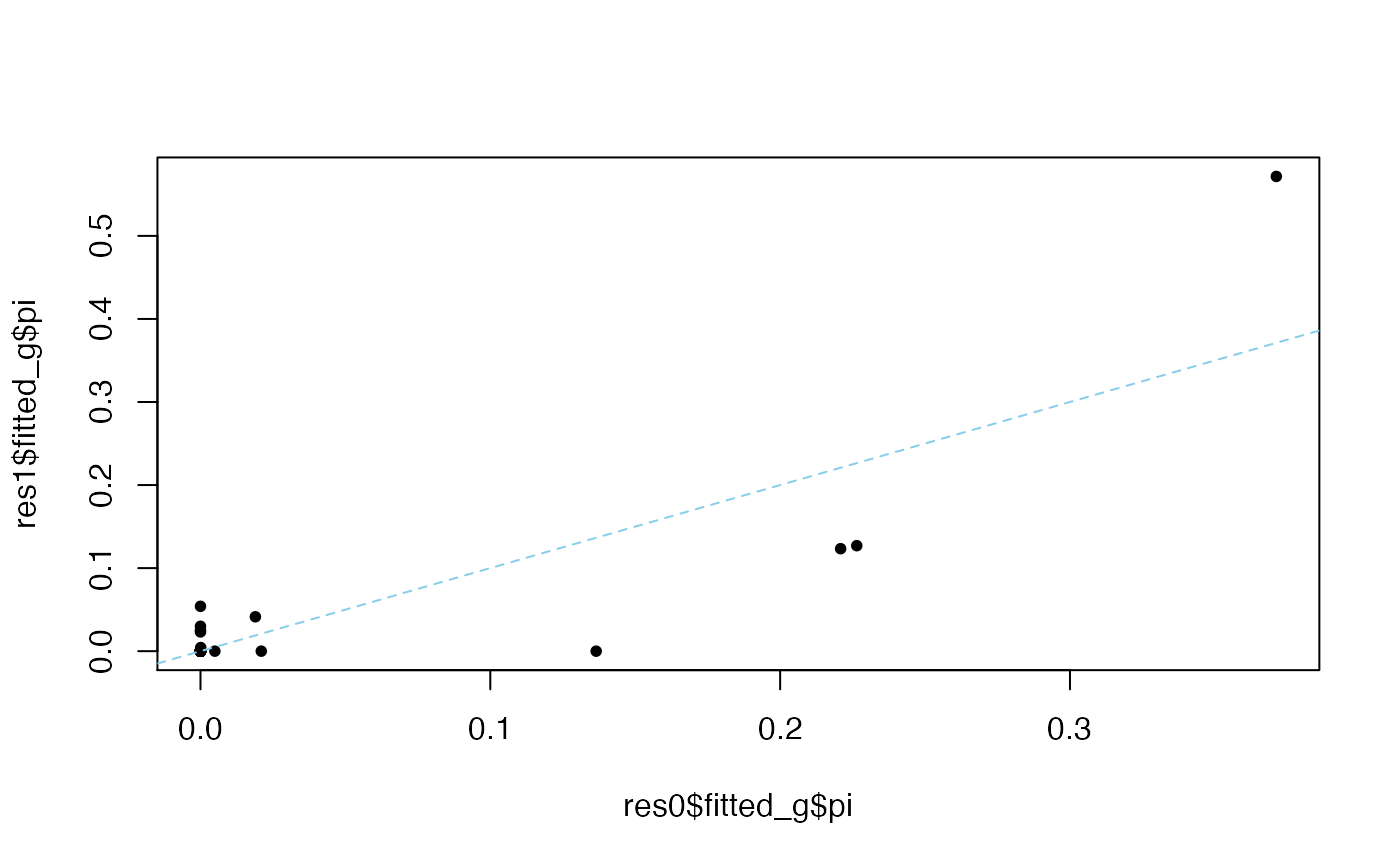Apply mash method to data
mash(
data,
Ulist = NULL,
gridmult = sqrt(2),
grid = NULL,
normalizeU = TRUE,
usepointmass = TRUE,
g = NULL,
fixg = FALSE,
prior = c("nullbiased", "uniform"),
nullweight = 10,
optmethod = c("mixSQP", "mixIP", "mixEM", "cxxMixSquarem"),
control = list(),
verbose = TRUE,
add.mem.profile = FALSE,
algorithm.version = c("Rcpp", "R"),
pi_thresh = 1e-10,
A = NULL,
posterior_samples = 0,
seed = 123,
outputlevel = 2,
output_lfdr = FALSE
)Arguments
- data
a mash data object containing the Bhat matrix, standard errors, alpha value; created using
mash_set_dataormash_set_data_contrast- Ulist
a list of covariance matrices to use (see
normalizeUfor rescaling these matrices)- gridmult
scalar indicating factor by which adjacent grid values should differ; close to 1 for fine grid
- grid
vector of grid values to use (scaling factors omega in paper)
- normalizeU
whether or not to normalize the U covariances to have maximum of 1 on diagonal
- usepointmass
whether to include a point mass at 0, corresponding to null in every condition
- g
the value of g obtained from a previous mash fit - an alternative to supplying Ulist, grid and usepointmass
- fixg
if g is supplied, allows the mixture proportions to be fixed rather than estimated; e.g., useful for fitting mash to test data after fitting it to training data
- prior
indicates what penalty to use on the likelihood, if any
- nullweight
scalar, the weight put on the prior under “nullbiased” specification, see “prior”.
- optmethod
name of optimization method to use
- control
A list of control parameters passed to optmethod.
- verbose
If
TRUE, print progress to R console.- add.mem.profile
If
TRUE, print memory usage to R console (requires R library `profmem`).- algorithm.version
Indicates whether to use R or Rcpp version
- pi_thresh
threshold below which mixture components are ignored in computing posterior summaries (to speed calculations by ignoring negligible components)
- A
the linear transformation matrix, Q x R matrix. This is used to compute the posterior for Ab.
- posterior_samples
the number of samples to be drawn from the posterior distribution of each effect.
- seed
A random number seed to use when sampling from the posteriors. It is used when
posterior_samples > 0.- outputlevel
controls amount of computation / output; 1: output only estimated mixture component proportions, 2: and posterior estimates, 3: and posterior covariance matrices, 4: and likelihood matrices
- output_lfdr
If
output_lfdr = TRUE, output local false discovery rate estimates. The lfdr tends to be sensitive to mis-estimated covariance matrices, and generally we do not recommend using them; we recommend using the local false sign rate (lfsr) instead, which is always returned, even whenoutput_lfdr = TRUE.
Value
a list with elements result, loglik and fitted_g
Examples
Bhat = matrix(rnorm(100),ncol=5) # create some simulated data
Shat = matrix(rep(1,100),ncol=5)
data = mash_set_data(Bhat,Shat, alpha=1)
U.c = cov_canonical(data)
res.mash = mash(data,U.c)
#> - Computing 20 x 121 likelihood matrix.
#> - Likelihood calculations took 0.00 seconds.
#> - Fitting model with 121 mixture components.
#> - Model fitting took 0.05 seconds.
#> - Computing posterior matrices.
#> - Computation allocated took 0.00 seconds.
# Run mash with penalty exponent on null term equal to 100.
# See "False disovery rates: a new deal" (M. Stephens 2017),
# supplementary material S.2.5 for more details.
set.seed(1)
simdata = simple_sims(500,5,1)
data = mash_set_data(simdata$Bhat,simdata$Shat)
U.c = cov_canonical(data)
res0 = mash(data,U.c)
#> - Computing 2000 x 151 likelihood matrix.
#> - Likelihood calculations took 0.05 seconds.
#> - Fitting model with 151 mixture components.
#> - Model fitting took 0.57 seconds.
#> - Computing posterior matrices.
#> - Computation allocated took 0.01 seconds.
res1 = mash(data,U.c,prior = "nullbiased",nullweight = 101)
#> - Computing 2000 x 151 likelihood matrix.
#> - Likelihood calculations took 0.04 seconds.
#> - Fitting model with 151 mixture components.
#> - Model fitting took 0.54 seconds.
#> - Computing posterior matrices.
#> - Computation allocated took 0.02 seconds.
plot(res0$fitted_g$pi,res1$fitted_g$pi,pch = 20)
abline(a = 0,b = 1,col = "skyblue",lty = "dashed")
